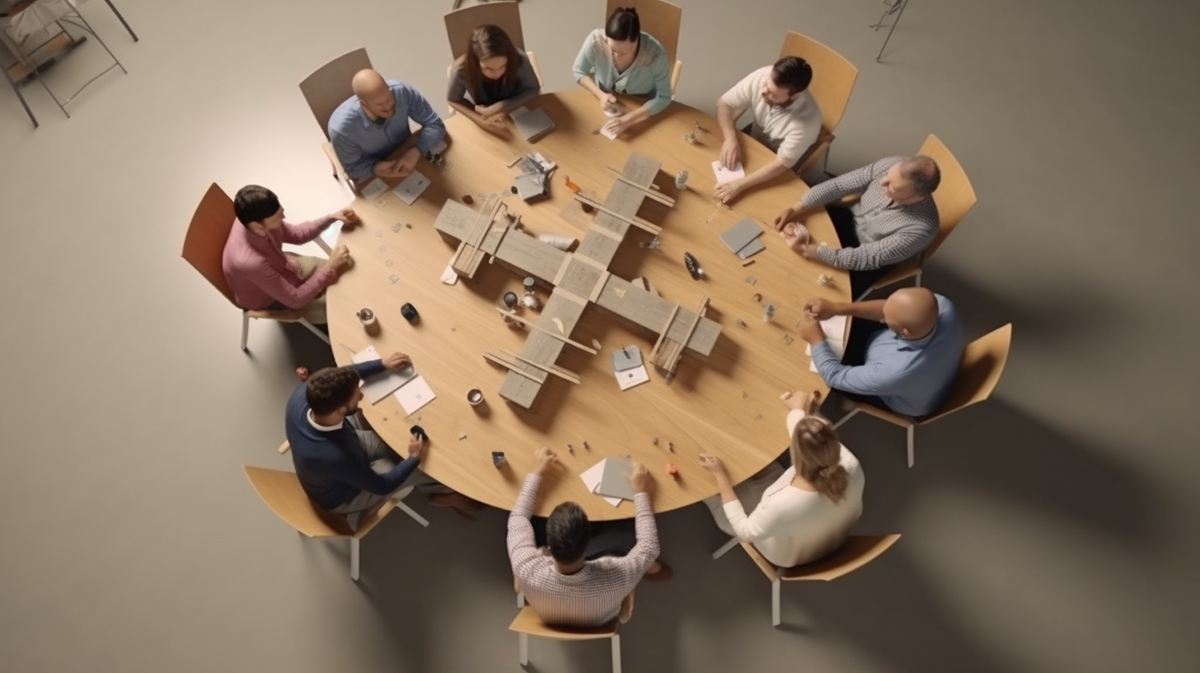How do you define a great employee? The answer is most likely dependent on who is attempting to respond, the employee or the employer. I will concede that I have told previous employers that I would be the best employee they have ever had. And I actually meant it when I said it. Did it happen? I like to think so; at least once or twice, but it’s not for me to say. Andrew and I have been both employee and employer, and this is a topic that I think deserves a little time in the spotlight … Welcome to Ep 125: A Great Employee
[Note: If you are reading this via email, click here to access the on-site audio player] Podcast: Embed Subscribe: Apple Podcasts | Spotify | Android | iHeartRadio | TuneIn

A Great Employee – Definitions jump to 2:10
As a primer to the conversation, I thought it would be useful to get an understanding of what other people think makes a great employee. To do this, I sought out the input of people from different age brackets, different stages of experience, architects, interior designers, landscape architects, and owners – just to see if there was a pattern in place that presented itself regardless of the baggage people were bringing with them. Turns out that people generally have the same idea of what makes for a great employee.
Miranda Davis – Architect at BOKA Powell:
“A great employee first takes care of all the tasks they are assigned in the time that they were given/gave themselves. This includes taking notes/mental notes to facilitate that in the capacity that they know they will need to not forget/miss steps (self-awareness). They communicate well, giving notice as soon as they realize they might not finish something on time, giving their team a chance to pivot if needed. They cannot go above and beyond without first fulfilling the original assignment thoroughly and on time, otherwise the extras cannot be appreciated. They listen actively and ask good questions after first troubleshooting on their own, acknowledging that everyone’s time and brain-space is important. They present a willingness to take on other tasks to learn and grow with a good attitude, bonus points for visible enthusiasm.”
Brannon Heake:
“What makes “a great employee” is not only willing to go the extra distance, but also know when it is necessary to do so. A great employee creates healthy boundaries with work, instilling a sense of pace, forecast, and rigor with a project. Lastly, having the self-awareness to remain cool and collected and check your ego at the door is critical. Although hierarchy is important, a great employee looks at their team as a collective rather than who oversees whom.”
Paul Freeland – Landscape Architect Kimley-Horn:
“A great employee thinks critically about their task and the deliverables at hand. They are proactive, checking quality in their work, holding themselves to a high standard. They solve problems on their own and are great at follow-up internally and externally. They are self-motivated and collaborative, with a positive attitude and a willingness to help their team in times of need. They are easy going, open to feedback, and don’t take themselves too seriously.”
Melanie Hanna – Interior Designer BOKA Powell:
“A great employee is subjective and can greatly vary depending on a company’s leadership style, culture, and values. For me personally, a “great employee” can be defined as a self-motivated individual who has excellent communication skills, embraces a growth mindset, and is aligned with the company’s mission, vision, and values. This individual is respectful, celebrates success, learns from failures, and has a “rising tide lifts all ships” mentality.”
Nick Thorn – Architect at Marlon Blackwell Architects:
“A great employee has many positive traits and attributes, but first and foremost, they are effective communicators because this leads to positive engagement with others. They also possess a duality of other important traits; confidence in their abilities while remaining humble, understanding their role while striving to advance their career, and being knowledgeable while continually learning more. Maintaining a balance between these characteristics is the mark of a great employee.”
Andrew Bennett – Partner and Owner at BOKA Powell
“Great employees are dedicated and focused and understand quickly the ability to deliver what’s asked and not too little or not too great. Great employees have a greater intuition, or have been educated, on how things get built … constructability. Great employees have a high RPM energy combined with a massively positive attitude for jumping into the fray and a hunger to be a good compliment to the larger team.”
Ian Nelson – Delivery Architect for Microsoft
“Knows when to say “no”. Knowing our limits, what is feasible (cost, time, quality, even possible technically) is very important at all stages of career. The trick is knowing when and how to say no, coming up with alternatives, sensing the other party’s direction. Mentor others and is a mentee themselves. We all have unique perspectives and skills, sharing those with co-workers is big plus. Doesn’t feel they have to live in a “box” of a role. I think that everyone should expand their role definition over time. For example, I don’t want all architects to be identical in a particular area, maybe one expands into their passion for lighting study or how a design impacts landscape selection, etc.”
Luis Spinola – Project Designer at BOKA Powell
“A great employee should be accountable for themselves, able to acknowledge successes and shortcomings and potentially missteps. Accountability is also an aspect of honesty.”
There were several keywords and phrases that almost everyone touched on in their definition of what makes a great employee – “collaborative” and “good communicator”. The only thing that I was surprised by when going through and discussing these definitions, is that these traits, really the entire definition, don’t have anything to do with architecture. They are also traits that people start developing as children.

Getting Ahead jump to 25:31
I also decided to turn to the internet to see what others thoughts, and there are a lot of opinions out there, so I started my search by trying to find information from the “employee” perspective and the query so instead of searching for “what makes a great employee?” the search was centered around “What do the most successful people as defined by raises, promotions and job opportunities, do to get ahead of their peers?”
- While receiving a promotion is something to celebrate, successful people don’t see it as the end goal.
- They actually like their job.
- They don’t say yes to everything. (hypocritical post – “ You Should Say ‘Yes’ More Often“)
- They use their mistakes as a springboard to self-improvement.
- They look for opportunities to get in front of others. Think engagement rather than socialize … which is next on the list.
- Socialize: They socialize – this one will probably make some people irritated but it showed up on a lot of the lists I read through.
- Stay Positive: remember that no matter how close your deadline or how heavy your workload is, other people will take their cues from you. “If you’re snapping at co-workers and frowning, they’ll snap and frown right back. Instead, take a breath, put on a smile, and show that you are exactly where you are supposed to be.”
- They think like employers, not employees.
The information collected and discussed in this section is interesting because the point was to find out if there was a particular skill set or behavior that people who are currently in an employee (rather than employer) position.

What Works For Me jump to 54:02
This is my list from 2013 – I think it is important to note that I was not in a leadership position at the time, and this is more of a list of personal reflections and what I felt was important. I will readily admit that this would not be the list I would make today – which is not the same thing as saying these don’t matter or provide value. These are just the things that I thought would make things better when I imagined what an employer would want from their employee.
Make the firms problems your problems
Everybody likes the person who helps make their life a little easier. Making the effort to say “I can take care of this” and actually being able to care of things will always get you noticed as someone who can be counted on in a crisis. Solving these problems normally requires extra effort, extra time, and extra risk … but these are the only things that will get you more responsibility.
Seek out opportunities
One thing that I always did that it seemed that few of my fellow architect co-workers did was go and ask my employers for additional responsibility. I believe that the employee/employer relationship works best for both groups when communication flows in both directions. While it is up to your employer to find you meaningful work to do, they can’t read your mind. If there are responsibilities that you WANT to do, you need to go and ask for it.
Learn the business vertically
This is an easy one – if you want to be the boss one day, you need to learn how to do the boss’s job. In order to positively impact other areas of the business, you have to step outside your comfort zone and learn some new skills … you might have to read a book or take a class. It’s what I’ve done in the past and I learned skills that I’ve been able to carry with me. You can also look at scheduling lunch and learns, seminars and course materials to supplement your skillset.
Resolve problems before they become problems
One of my favorite lessons (or maybe it’s a quote that I’ve co-opted into my own) is:
“Do what you say you’re going to do when you say you’re going to do it.”
If you consistently fail or let down the people who count on you, why would they ever come back to you for assistance? Staying ahead of the issues is actually more important than how you are able to handle those issues once they’ve become problems.
Help hide the bodies
Sometimes, you have to tow the company line and take one for the team. As a residential architect, I have found myself in some situations that put me right in the middle between the clients I work for and the employers who pay my salary. When you think your employers are wrong, you need to stop a minute before you do something you regret and think about what happens tomorrow and the next day. This isn’t about compromising your values, this is about deciding which team you’re going to play for … and sometimes that means digging a hole and jumping in it. (the post I mentioned in the podcast Attitude Reflects Leadership and Your Behavior Matters)
I had some fun revisiting the post I originally wrote 10 years ago – mostly to see how my thoughts on the matter have changed. I still think this is a pretty good list, but I think there is a difference now between the priorities that I set and how I articulate them.

What the Rank jump to 64:18
We are bringing out a bottom three on this episode – we haven’t done one in a few months and this one just kind of fell into my lap.
Today we are ranking [drum roll please] ….
The Worst Three Color Names for Crayons
| #3 | #2 | #1 | |
| Andrew’s Worst Crayon Names | Manatee | Razzmatazz | Bittersweet |
| Bob’s Worst Crayon Names | Oatmeal | Inchworm | Beaver |
Worst three names for crayon colors. How did you decide – straight-up names or if the name doesn’t conjure up some idea of what the color actually is? I went with names I don’t really want to say because they sound ridiculous. I also came to the conclusion that I don’t like standalone animal names as colors … I just feels lazy. Andrew based his selections on if the name evoked an appropriate color … based on his selections, I’d say that was a sound strategy.
Honorable mention: Fuzzy Wuzzy, Middle blue purple, maximum yellow-red
Ep 125: A Great Employee
This discussion, centered around the idea of being “a great employee”, has been an interesting tool for me, if for no other reason than taking the time to put into words what it means to be a great employee. It is hard to separate my thoughts of what this means when I think of how things have evolved for me over the past 30 years of my career. Obviously, I have spent way more time as an employee and I know that where I found motivation has changed as my life has evolved. Andrew has actually spent more time as an employer than an employee and his perspective certainly reflects the responsibility that comes with trying to make sure that your employees get what they need and that you can keep the doors open. This is one of those topics where everyone will evolve and pivot on their positions and the idea is that you can still remember what it meant to be an employee when you are in the position as an employer. Proactive, high standards, personal accountability, collaboration, and critical thinking … these 5 traits would find a place in my current definition.
Let me know what your definition looks like below.
Cheers,
Bob

Special thanks to our sponsor Construction Specialties, maker of architectural building products designed to master the movement of buildings, people, and natural elements. Construction Specialties is so focused on the importance of mastering movement, that they have created a CEU specifically on mastering movement on the job site with modular stairs. Each course is worth 1 AIA LU/HSW and is part of the Mastering Movement Academy by CS. Visit masteringmovement.net to take this and other courses.
